A false ceiling differs from a traditional ceiling made of decorative materials such as gypsum board, PVC panels, and tiles, among other things. There is an empty gap between the ordinary ceiling and the false ceiling. The fake ceiling is a great material to use in halls and auditoriums to improve soundproofing. Metal wires are used to secure the artificial ceiling from the original ceiling. When the floor height is more than 10 feet, the space between the ceiling and the fake ceiling extends up to one foot. The artificial ceiling is a metal grid supported by the original ceiling and suspended.
The artificial ceiling not only improves the room’s aesthetic but also conceals the room’s heavy wiring, pipes, and insulations. A false ceiling is utilized in many multi-story offices and business buildings to offer an HVAC system that distributes clean air to the space. This system is readily repaired by simply removing the ceiling panel in the affected region and reinstalling it. The fake ceiling technology is less expensive and easier to install.
Types of False Ceilings:
False ceilings come in a variety of shapes and sizes in the home. False ceilings are classified in various ways based on their intended use, materials used, look, and visibility. On the other hand, the most popular categorization is required on the materials utilized. The eight most common varieties of fake ceilings are listed below.
1. Gypsum False Ceilings
2. Plaster of Paris (POP) False Ceilings
3. Wooden False Ceilings or Plywood False Ceilings
4. Metal False Ceilings
5. PVC False Ceilings
6. Fabric or Cloth False Ceilings
7. Mineral Fibre False Ceilings
8. Glass False Ceilings
1.Gypsum False Ceilings:
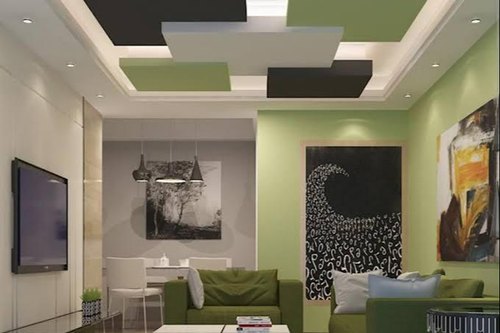
Fig 1: Gypsum False Ceiling
Courtesy: myhomedesign.in
Gypsum boards, sheets, or ceiling tiles create a false gypsum ceiling. Ceiling tiles are smaller than gypsum boards. Gypsum false ceilings are durable, adaptable, and cost-effective. It is a sterile calcium sulfate that is lightweight and simple to install. Gypsum is a sable for drop ceilings since it is fire-resistant and soundproof. Gypsum ceiling tiles are typically 600 mm by 600 mm in size. With the help of the metal frame, they arranged in square planks. Finishing gypsum board ceilings with paints, laminates, or wallpapers can improve the aesthetic of the home’s interiors.
2. Plaster of Paris (POP) False Ceilings:
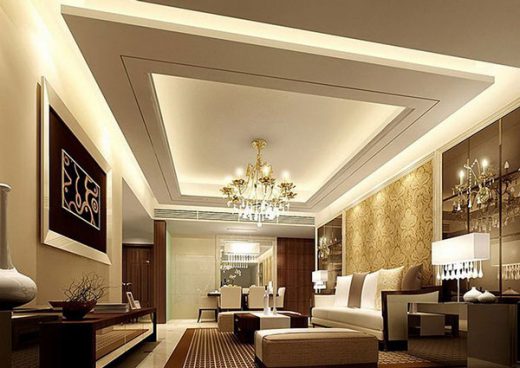
Fig 2: POP False Ceiling
Courtesy: beautifulhome.com
The most popular false ceiling material is plaster of Paris (POP). When gypsum is heated, it softens and releases water, forming POP! POP quickly hardens when water is added.It’s painted on a fiberboard or wood basis and then suspended from the ceiling to create a faux ceiling. The POP artificial ceiling has a nice appearance and a long lifespan. They’re great at insulating heat. This type of drop ceiling conceals unsightly construction elements such as ventilation pipes and conduits and gives the ceiling a smooth surface.
3. Wooden False Ceilings or Plywood False Ceilings:
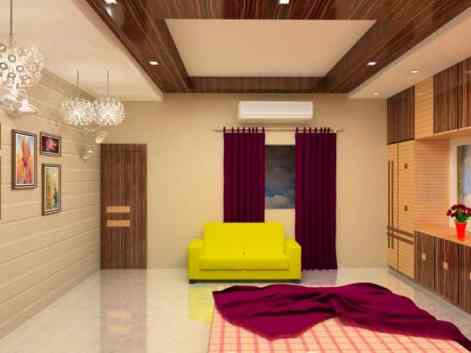
Fig 3: Wooden False Ceiling
Courtesy: livspace.com
Some homeowners like natural and country-side beauty and serenity in their house interiors. Using wooden beams on the ceilings is the best method to get this rustic aesthetic. These wooden panels can create various patterns on the ceiling, giving it a modern and appealing appearance. False ceilings made of wood are also a great focal point for a room. Wooden false ceilings are becoming increasingly popular among modern homeowners due to their natural textures and designs. Different treatments are applied to these ceilings to make them more appealing. Hollow wooden blocks, wooden panels, wooden boards, and plywood create artificial wooden ceilings. The wooden blocks are simple to put together using nails and screws—this type of ceiling is better for cold weather areas.
4. Metal False Ceilings:
Metal is a durable home décor option. Ceiling tiles, planks, and panels are all options for false metal ceilings. Galvanized iron and aluminum are the most frequent metals used for drop ceiling
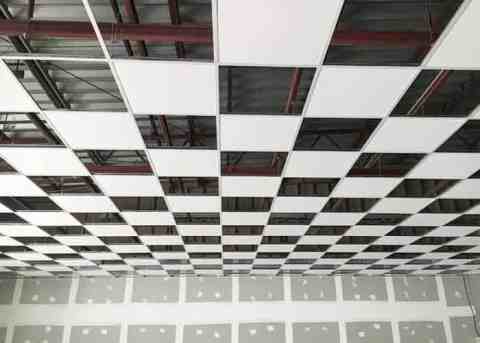
Fig 4: Metal False Ceiling
Courtesy: happho.com
To produce a fake internal ceiling, metal ceiling tiles of various sizes and thicknesses are available Metal ceiling tiles or panels can be suspended from the ceiling and put on a visible steel grid with T-sections or cross-sections. According to ‘Armstrong World Industries (AWI), these tiles, a global leader in the design and manufacture of unique commercial and residential ceiling, wall, and suspension system solutions, are available in various styles and can provide a historical look with a modern twist! Therefore, metal ceilings are an excellent alternative for false ceiling designs in living rooms and other high-traffic areas.
5. PVC False Ceilings:
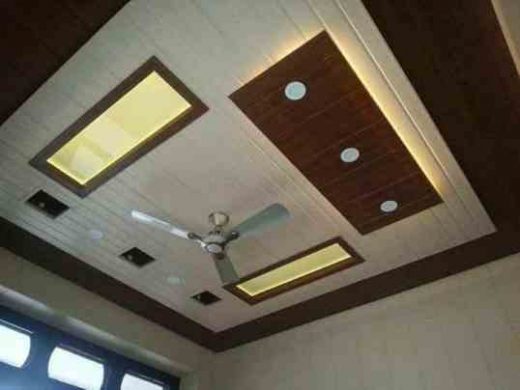
Fig 5: PVC False Ceiling
Courtesy: homelane.com
PVC ceilings are lightweight, water-resistant, and an excellent solution to keep water from leaking through the ceiling. Because PVC ceiling tiles are easy to clean and maintain, they alleviate the problem of unclean and unsanitary ceilings. It’s one of the few forms of fake ceiling that’s simple to install, lightweight, waterproof, termite-resistant, and requires little upkeep. Because they are non-porous and non-absorbent, they can readily handle flush-fitting ceiling lights, various types of lighting, access hatches, air vents, and sprinklers. They come in a variety of colors and can be painted or polished.
6. Fabric or Cloth False Ceilings:
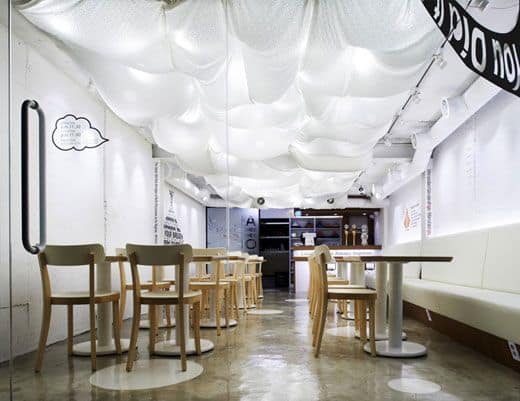
Fig 6: PVC False Ceiling
Courtesy: buildingsandinterior.com
Fabric is inexpensive and covers across the ceilings in places like churches, yoga rooms, restaurants, ballrooms, and function halls for temporary uses. They are not recommended because they accumulate dust over time. The light emitted by materials has a good intensity and produces a warm environment in the space. This artificial ceiling isn’t as functional as others, but it improves a room’s appearance.
7. Mineral Fibre False Ceilings:
Mineral fiber ceiling tiles are made from natural or synthetic minerals. Mineral tiles made of ceramics are used in a drop ceiling, strengthened with natural stone, wood, vegetable fiber, bitumen, and tars. These components improve the product’s insulating capacity. As a result, they’re suitable for areas where both heat and sound insulation are required. Mineral fiber ceiling tiles come in many sizes, shapes, and designs. They are inexpensive and simple to set up.
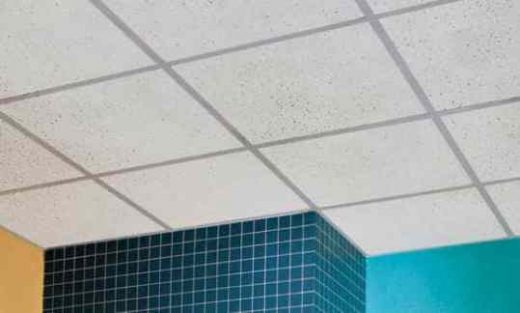
Fig 7: Mineral Fibre False Ceiling
Courtesy: stylemotivation.com
8. Glass False Ceilings:
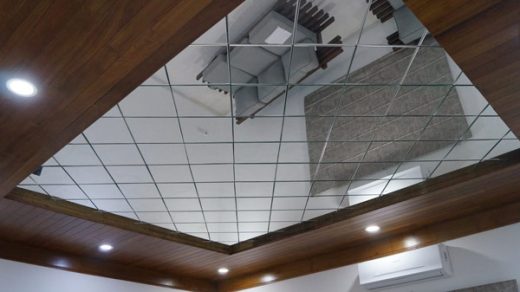
Fig 8: Glass False Ceiling
Courtesy: myhome-saint-gobain.com
Glass is a transparent, non-crystalline, brittle substance. Because of its transparency, it makes a living or working space appear larger and grander. As a result, it can apply in areas like restaurants and libraries as a false ceiling. Glass is also an excellent heat insulator. Certain admixtures or techniques are used to make glass non-brittle and opaque. It ensures the safety of false glass ceilings and addresses the issue of privacy.
Conclusion:
There are several kinds of artificial ceilings that are mainly used. Some of them are pricey, while others are not. The best artificial ceilings are made of gypsum and Plaster of Paris. These are pricey, but they last a long time. However, for greater longevity, better artificial ceilings would be beneficial. A fake ceiling to an existing or new interior design concept brings life to the room. It also adds to the room’s coziness while also helping to save money on energy bills.
References:
1. 6 Types Of False Ceilings Using Pop In Interiors | My Decorative. (2020, October 27). My Decorative. https://mydecorative.com/6-types-of-false-ceilings-using-pop-in-interiors/.
2. L. (n.d.). Everything You Need To Know About False Ceilings (Cost Included). Livspace Magazine. https://www.livspace.com/in/magazine/decor-pillar-false-ceiling.
3. Menon, M. (2018, August 27). False Ceiling Materials: The Different Types And Where To Use What – The Urban Guide. False Ceiling Materials: The Different Types and Where to Use What – The Urban Guide. https://www.urbancompany.com/blog/interiors/false-ceiling-materials/.
4. False Ceiling: Types, Advantages & Disadvantages. (2020, May 4). Constructionor.Com. https://constructionor.com/false-ceiling/.
5. What Is False Ceiling? Types Of False Ceiling, Advantages. (2020, July 26). Civil Knowledge. https://www.civilknowledges.com/what-is-false-ceiling-types-false-ceiling/.
If you have a query, you can ask a question here.



ceiling design required